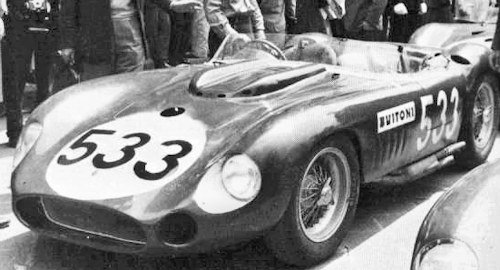Maserati 350S race car
 |
|
|
Manufacturer |
Maserati |
|
Class |
Race car |
|
Production |
from 1955 to 1957 |
|
Produced |
3 |
|
Drive |
rear-wheel-drive |
|
Transmission |
5-speed manual |
|
Length |
4200 mm |
|
Width |
1500 mm |
|
Height |
980 mm |
|
Step |
2325 mm |
|
Mass |
780 k g |
The 350S is a racing car built by Maserati from the 1950s.
History
The 350S was Built in with only three copies, the model was designed by Giulio Alfieri , while the bodywork was the work of Medardo Fantuzzi . It had no doors and was two-seater. It was rear-wheel drive.
The engine was heavily revised for racing purposes was around 3,500 cc, and was totally new. It had little in common with the one installed on the Maserati 300S, which had reached its maximum development. Fitted with a five-speed gearbox. suspension coil springs with dual hydraulic shock absorbers. On the rear ones the De Dion bridge was installed with cross leaf spring and double hydraulic shock absorbers.
The first car produced with chassis number 3501 was developed in 1955. It was used a motor at the design stage a six-cylinder designed for future Maserati 3500 GT. This came with a double overhead camshaft in head and 3485 cc of displacement with carburettors type Weber 42 DCO3 Two different variants were made. One featured a dry sump lubrication system while the other features a wet sump lubrication system. Power of 220 bhp at 5500 rpm. During the Mille Miglia of 1956 Stirling Moss had an accident with this car, which was later demolished.
The second car produced, with chassis number 3502, was rather similar to the first and was purchased by Luigi Piotti . The engine power was 325 bhp at 6200 rpm. It was later purchased by Tony Parravano in 1957 and sold in Connecticut n 1974 where it still is.
The third car was presented at the beginning of 1957 with chassis number 3503. At first a six-cylinder in -line engine was used, later converted into a 3500 cc V12 delivering 335 bhp at 9000 rpm. An engine failure prevented Hans Herrmann from participating in the 1957 Mille Miglia. It was later used by Luigi Piotti and Roberto Bonomi in the 1000 km of Buenos Aires (1957).
